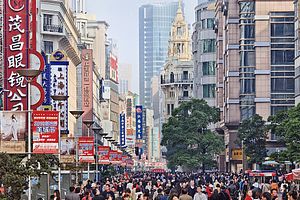Dwindling growth indicators for China have been reported extensively in the media in recent months, so much so that little space has been devoted to coverage of growth areas. It turns out that, even as railway transportation of so-called “black goods,” or steel and coal, has fallen, transport of “white goods” for household consumption is up. Indeed, consumption is on the rise, reflected in its increased contribution to GDP in 2015 and steady consumer sentiment.
It should be noted that both retail and online sales of consumer goods are growing. While still not as strong as year-on-year growth in 2011 and 2012, growth has been close to or above 10 percent. Consumption is becoming an ever-more important component of GDP, now weighing in at or above half (depending on the period of measurement). Consumer-oriented listed companies have enjoyed rising profitability. Consumer confidence remains relatively high and above the baseline level of 100.
Brick-and-mortar shops are selling, but in some cases appear to be losing turf to online retailers. Through both government and private promotion, e-commerce has been boosted. Alibaba is the leader in online retailing, helped by the variety of products it offers at competitive prices. Alibaba’s Taobao, now a household name, has even launched campaigns to nudge Chinese farmers to sell through the website, which would go a long way to clinching the rural market. Consumers are also increasingly using digital payment systems for online purchases, revealing higher trust in online security than before.
Sales of everyday goods are performing well, while luxury goods continue to lag due to the government corruption crackdown on purchases of high-end goods and uncertain economic expectations. Luxury cars, Swiss watches, upscale brand name goods, and expensive spirits have all experienced poor results on the Mainland in recent months. Despite this, in some overseas locations, such as Japan, luxury sales to Chinese shoppers have increased, and online international sales of luxury goods to China have also risen. Aspirational luxury goods are increasingly marketed to a brand-conscious middle class.
National holidays such as Chinese New Year have brought with them a surge in consumption. In the lead-up to this Chinese New Year, Alibaba experienced a spike in online transactions starting in late January. Clothing, food, appliances, and digital products were among the most popular goods purchased.
While Americans continue to consume, per capita, 53 times more goods and services than the Chinese, consumption appears to remain healthy in China. The urbanization process continues apace, unemployment remains stable, and incomes have risen, creating the perfect storm for raising living standards through purchases of white goods and other consumer products. So, while black goods are down, white goods are up. It looks like one major policy goal, to drive up consumption, is being met.

































